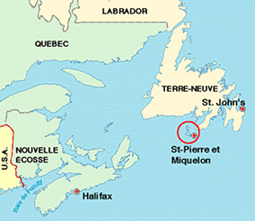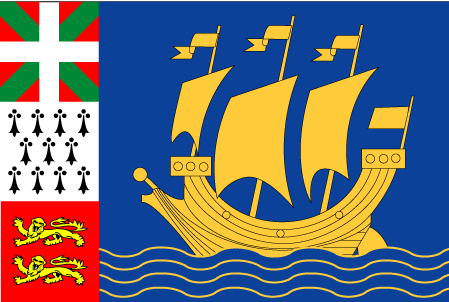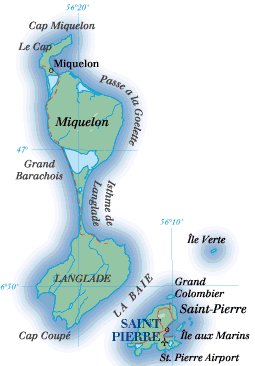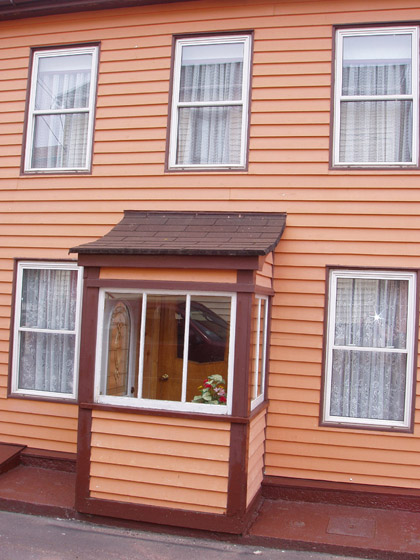| Library | Lane | Search Lane | Catalog |
| Contact Us | Web Site Accessibility |

| Don Macnaughtan | Lane Community
College Library Eugene, Oregon 97405 macnaughtand@lanecc.edu |

 "If St. Pierre exists in an indeterminate Atlantic space, it also seems slightly lost in time. Since about a third of its inhabitants are on temporary assignment from the Metropole, as the St. Pierrais call continental France, this is mysterious, but undeniable." |
The colors of St.-Pierre et Miquelon
 2004 Don Macnaughtan
2004 Don Macnaughtan
Click here for my series of photos on the houses of St. Pierre.
The town of St. Pierre is the capital of the French territory of St. Pierre et Miquelon. This archipelago is the last remnant of France in North America, and consists of the small island of St. Pierre, and the larger islands of Miquelon and Langlade. The islands are off the southern coast of Newfoundland. About 5,600 people live on St. Pierre, and another 700 on Miquelon. Langlade is uninhabited, although some St-Pierrais have summer homes there, and the locals like to go over to hunt deer and rabbits.



I visited these islands in August 2004, and was impressed by the plain but colorful architecture of St. Pierre. The town of 4,000 is packed closely around the main harbor; most houses date from the first part of the 20th century, after a series of fires destroyed the old 19th century town. St Pierre had a burst of prosperity in the 1920s, when it was the base for smuggling liquor to the east coast of the US. There are even a few houses built from the discarded whiskey cases. Since the collapse of the cod fishery, St. Pierre has largely depended on subsidies from Metropolitan France, which pours $60 million a year into the local economy.
The islands themselves are fairly barren, with only low salt-blasted forests. The short growing season means that only the hardiest plants thrive. The locals like to say that they are literally French soil, since the best growing dirt arrived as ship ballast. As if to compensate for their bleak surroundings, the St-Pierrais are proud of their little town, and express themselves in colorful architecture.
An unusual feature of the houses is the tambour, a small enclosed porch projecting out into the street. This has the practical effect of allowing everyone to get their wet gear off before going inside - a local variant on the mud room. The tambour was noted in St. Pierre's most recent claim to fame - a juicy article in the New York Times from June 13 2004 (we booked before the article, but it doesn't seem to have affected SPM's rather slow tourist traffic).
- "St.-Pierre's lovable houses, built from wood imported from New England because it withstood the humid cold, often include a tambour, a small, closed entrance, frequently with a flirtatiously curved roof. Built right to the street in cheek-by-jowl closeness, the houses strut their turquoise, Day-Glo green and Schiaparelli-pink hues. The trim colors are equally uninhibited and unexpected, a Latin thumbing-of-the-nose at the gray surroundings ....
- The first settlers were Basque, Norman and Breton fishermen. The flags of the Basque country, Britanny and Normandy are still represented in the local SPM banner.
- There is a pelote court (a "fronton basque") for playing the old Basque game, and Basque food and pride are still extant.
- SPM was the first bit of France to be liberated in WW II. A Free French force sailed over from Halifax and evicted the Vichy governor. Even tho Washington diplomats complained loudly to de Gaulle about his "arbitrary" action, this was a great morale-boster for the Allied cause.
- SPM has an odd political status as a "territorial collectivity" of France. Nobody is quite sure what this means, but the locals send a senator to Paris, and reap big benefits from EU membership. The only other "collectivity" is the island of Mayotte, in the Indian Ocean.
- SPM has its own stamps and license plates.
- There is a big contingent of gendarmerie on the islands. They watch everyone disembarking from the planes and ferry. Rumor has it that they are there to stop the locals getting out of hand when France occasionally threatens to cut off the largesse flowing from Paris. It is apparently a plum assignment.
- About 80% of the goods are imported once a week by supply ship from Halifax, but cars are French, and electrical and electronic gear only run on 220v. I saw one old Ford Fairlane, but otherwise a vast array of Renaults, Peugeots, Citroens, etc.
- About a third of the population are from Metro France, on 2 and 3 year assignments.
- The locals have a distinct dialect - "very fast" according to some.
- Langlade has deer and rabbits, and there is a seal colony - but the foxes have disappeared, according to the local hunters.
- Sometime in the 18th century, the separate islands of Langlade and Miquelon became linked by a narrow sandspit - built up on the bones of dozens of ships wrecked in the passage.
- Even tho the town is tiny, everyone seems to drive, barrelling around the streets in fine European fashion. No bikes, few pedestrians.
- One of the local delicacies is cod testicles - who knew?
- There are about a dozen festivals each summer, including a Blessing of the fleet, music and sailboat festivals, a 25km footrace on Miquelon, the Grand Banks dory race, and the annual Basque fair.
- Two accessible parks are located on Miquelon - the Cap de Miquelon, and the Grand Barachois lagoon.
Books, articles and websites about SPM
A Touch of France on the Side
Katherine Ashenburg New York Times June 13 2004: 5.10.
Article URL
"ONE of the first things I learned when I moved to Canada more than 30 years ago had very little to do with Canada. It was that there were two small islands nestled just south of Newfoundland that were bizarrely and completely French, down to gendarmes, francs, 220-volt electricity and restaurants with three-course menus du jour. To a 23-year-old who had never been to France, St.-Pierre and Miquelon sounded glamorous, cosmopolitan and exciting. I resolved to go there as soon as I could.
Decades passed. I traveled many times to France, but St.-Pierre and Miquelon remained on the to-do list. When I saw the 2000 movie, ''The Widow of St. Pierre,'' starring Juliette Binoche and Daniel Auteuil, set on a moody, mysterious French outpost off the coast of North America, my determination rekindled. At last, in the summer of 2003, I flew from Halifax to St.-Pierre.
The traveler for whom the glass is half empty would report that the French islands turned out to be neither glamorous, cosmopolitan nor exciting. I take another tack: They are better than that, being genuine, rather vulnerable and larded with history. An odd compound of Canadian fishing town and France, St.-Pierre and Miquelon are finally like nothing but themselves.
Their settlement began in the 17th century with Basques, Bretons and Normans eager to fish the cod-rich Grand Banks. As France lost its other North American colonies from Canada to Louisiana, the little archipelago (two main islands and a smattering of tiny ones) gained symbolic importance. Between 1713 and 1814, the islands ricocheted between Britain and France no fewer than six times, with attendant deportations and repatriations. Securely French since the Treaty of Paris in 1814, St.-Pierre and Miquelon are a French toehold in North America, a distinction for which the mother country pays about $65 million annually.
Aside from its period as the littlest pawn in a French-English chess game, the islands' history is the history of cod fishing, which peaked in the late 19th century and plunged at the end of the 20th. There was a lucrative interval during Prohibition, when American rumrunners bought vast quantities of Canadian whiskey warehoused in St.-Pierre, but St.-Pierre and Miquelon remain fishing villages.
Although tiny, with 10 square miles to Miquelon's 83, St.-Pierre is the metropolis, with 90 percent of the islands' 7,000 people. At first, with its streetscapes congested with wooden houses climbing up from the harbor, St.-Pierre looks North American. Then you notice that the main square is called the Place du General de Gaulle, while the streets, commemorating Jacques Cartier, Louis Pasteur and other French notables, are traveled by Peugeots and Renaults. Policemen wearing flat-topped kepis congregate around the Gendarmerie, a big, hip-roofed building near the square.
St.-Pierre looks bleak, partly from its treelessness, partly because of the polar winds and fog that come with the Labrador Current. In full summer, it can be cool to cold. If it exists in an indeterminate Atlantic space, it also seems slightly lost in time. Since about a third of its inhabitants are on temporary assignments from the Metropole, as the St. Pierrais call continental France, this is mysterious, but undeniable.
The Hotel Robert, a pleasantly shabby clapboard inn where I stayed, reminded me of my first trip to France in 1969 -- towels with almost no nap, a flowery bedspread that fought with curtains in another pattern, a dollhouse-size bar of soap and no shampoo. The restaurants also hail from an era before cuisine minceur. Although the general standard is high and the fresh fish is excellent, the tendency is to robe many things in puff pastry, and when in doubt to bring on the creme patissiere.
Because this is France, the people are impeccably polite, with a reserve that doesn't lead to casual conversation with tourists. In my experience, the St. Pierrais are more outgoing than those from the Metropole, particularly two late-middle-aged women staffing the Hotel Robert's reception and breakfast room. They supplied me with advice, birthday congratulations after they took a message from home, and a tiny, antiquated 220-volt hair dryer. Puzzled by the salted butter rather than the usual French unsalted variety, I asked the breakfast room madame about it. First she denied that the butter was ''very salty,'' then she insisted, somewhat beside the point, ''But the French love salt!'' I can't say I found our conversation enlightening, but I enjoyed it.
Other than eating and drinking richly and nostalgically, what is there to do in St.-Pierre?
There are shops selling French things, including the Comptoir Importation Alcools, a liquor store stocked with Bordeaux and Burgundies (12 bis, rue Albert Briand). But neither the selection nor the prices were noteworthy. There are a few shops selling local crafts and foodstuffs, also not particularly enticing. Better to engage in St.-Pierre's best pastime, simply strolling or climbing its streets.
The town is so small you'll stumble across the sights, whether it's L'Arche, the town's dramatically contemporary museum; the World War I monument across from L'Arche; or the cemetery, crammed with above-ground tombs whose inscriptions detail the origins and often short lives of the St. Pierrais. I did need a French walking-tour pamphlet to find where an 1889 execution by guillotine took place (at the present Ile aux Enfants school, at the Rue Marcel Bonin). That event inspired ''The Widow of St. Pierre,'' so I had a proprietary interest.
The pockmarked Cathedral of St.-Pierre, built in 1905 in cement, a medium revolutionary at the time, has weathered badly. Initially, the interior is not much more inviting, but aficionados of stained glass will find its windows suggestive of St.-Pierre's close links with the Metropole and of a religion that has changed enormously in the last century. Sweetly pious early-20th-century windows celebrate French saints (St. Margaret Mary Alacoque, St. Bernadette and Our Lady of Lourdes) and the cement church in Montmartre that inspired the New World version. They're counterpointed by handsome modern windows donated by de Gaulle on a 1967 visit. The windows feature Gospel scenes appropriately involving ships and sea (a frequent subject of the traditional window also), as well as a portrait of Pope John XXIII and the ecumenical council.
On the square in front of the cathedral, a directional sign points to four key destinations: ''patisserie,'' ''hotels,'' ''Mairie'' (the city administration) and ''fronton Basque.'' The first three indicate that you are in a famously well-organized country that values tourists and good pastry. The patisserie in question is Bernard Guillard, at 23, rue Marechal Foch. In a green clapboard house, traditional delicacies with menacing names like souris (mice), religieuses (nuns) and nids d'abeilles (bees' nests) cry out to anyone with a half-functioning sweet tooth.
Although the tranquil village of Miquelon has less to recommend it, it makes a pleasant two-hour excursion, via a guided boat tour. There's a charmer of a church, Notre Dame des Ardilliers, with folk-art religious paintings and a ceiling that mimics the hull of a ship, as well as a minute museum with local curiosities and an exhibit of St.-Pierre and Miquelon stamps featuring island life.
Walking Miquelon's harbor and flat streets, admiring the kitchen gardens around almost every house, is a glimpse into this isolated way of life. A more poignant view comes at Ile aux Marins, a 10-minute boat ride from St.-Pierre. In the late 19th century, the island supported permanent residents and hundreds of summertime fishermen from Brittany, who cured their catch on flat shoreline stones and stored them in buildings called salines. The last year-round resident left in 1967. Today, visitors tour a ghostly ensemble that includes a fisherman's house, a combined house-saline-boat storage now a museum, the school, the church and outdoor stations of the cross.
Neither Ile aux Marins, nor Miquelon, nor St.-Pierre looked like my memory of ''The Widow of St. Pierre.'' Recently, I learned that the movie was shot in the restored French fortress of Louisbourg in Nova Scotia, for greater period flavor. I'm glad I didn't know that before I went, because the movie inspired a long-delayed trip that was well worth the wait.
Don't forget the euros
Air Saint-Pierre, (877) 277-7765 or at www.airsaintpierre.com, flies from Halifax, Nova Scotia ($382.50, round trip with tax, $1.39 Canadian to the United States dollar); St. John's, Newfoundland ($209.40, round trip with tax); and Sydney, Nova Scotia ($249.67), among other places. SPM Express, (709) 832-0429, operates a passenger ferry from Fortune, Newfoundland, that takes 90 minutes to St. Pierre ($61 round trip; reservations recommended).
Phone numbers on the island require the international dialing code 011. Americans need a passport.
Lodging and Dining
On the waterfront, Hotel Robert, 10, rue du 11 Novembre, (800) 563-2006, fax (508) 41 28 79, has 43 rooms and a raffish charm appropriate to a Prohibition-era hotel patronized by Al Capone. A tiny museum commemorates the island's era of booze-powered prosperity. A double room costs $128.35 (at $1.25 to the euro) and includes a Continental breakfast and friendly service.
Le Feu de Braise, 14, rue Albert Briand, (508) 41 91 60, has little in the way of decor, so concentrate on the succulent food. Dinner for two with scallop brochettes, pork with red wine, and a terrine of three chocolates will cost about $87 with wine.
Sightseeing
Tickets for the English-language guided tour to Ile aux Marins, leaving daily from May 1 to Sept. 30 at 9 a.m. and 2 p.m., cost $16 for adults, $10 for children. They are sold at the tourist information office, Place du General de Gaulle, (508) 41 02 00, www.st-pierre-et-miquelon.com, which also has tickets for the tour to Miquelon; $59 for adults, $33 for children. Tours leave every day from June 15 to Sept. 20, at 10 a.m. and 1:30 p.m.
Sometimes while traveling, I obsess on a particular material or thing. Once in Japan, I spent a week searching out all the possible uses for bamboo. In St.-Pierre, what took me by storm was that hallmark of the house-proud French, the lace curtain. Ranging from handmade heirlooms to mass-produced polyester, the curtains appear on the vast majority of St.-Pierre houses in an astounding variety of patterns. In a single block of the Rue Amiral Muselier, I noted tulips at No.50, a village scene with church and a second pattern with windmills, both at No.48, a lighthouse design at No. 46 and one with sailboats at No.43.
Elsewhere, in addition to innumerable flowers and flowerpots, I admired swans, girls in bonnets, clouds and a design of coffeepots and coffee grinder."

My series of photos shows some of St. Pierre's colorful houses.
Some tidbits about SPM:
| Lane Community College Library, Center
Building, 4000 East 30th Ave, Eugene, OR 97405 Questions or comments regarding this website can be directed to Don Macnaughtan. Email: macnaughtand@lanecc.edu. This page was last updated: 30 December, 2004 ©2004 Lane Community College |


